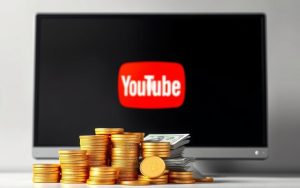Table of Contents
Creators often wonder about the financial potential of their videos. Earnings can vary widely, with some making thousands while others earn less. Factors like audience location, content niche, and engagement play a big role.
For example, finance videos tend to generate higher revenue than gaming content. Viral hits like Baby Shark show the massive scaling potential, but most creators operate in more modest ranges.
This article breaks down key elements that influence income. You’ll learn what separates top earners from average performers and how to optimize your strategy.
Understanding YouTube Monetization
The financial backbone of YouTube relies on two critical metrics: CPM and RPM. These determine how creators earn from ads, but they’re often misunderstood.
How YouTube Pays Creators
Revenue starts with advertisers bidding for ad space. YouTube takes a 45% cut, leaving creators with 55% of the generated income. This split applies after accounting for monetized views—views where ads are actually shown.
CPM vs. RPM: Key Metrics Explained
CPM (Cost Per Mille) reflects what advertisers pay per 1,000 impressions. The average hovers around $7.01, but niches like finance can reach $29.30.
RPM (Revenue Per Mille) shows what creators actually earn after YouTube’s cut. A $7.01 CPM might translate to just $2.89 RPM due to unmonetized views.
RPM = 55% of CPM × monetized view percentage
Gaming channels often struggle with lower CPMs ($1.61), while educational content thrives. The takeaway? Your niche directly impacts earnings potential.
How Much Money Does 1 Million YouTube Views Make?
Understanding potential earnings helps creators set realistic goals. The actual number varies widely based on content type, audience, and advertiser interest. Industry reports show ranges from $1,700 to $30,000 per million views.
Average Earnings per View
Most creators earn $3-$5 per thousand views. Finance channels like Joseph Hogue’s demonstrate higher potential, generating $24,592 per million views. In contrast, gaming content often falls at the lower end of the spectrum.

Revenue Range for 1 Million Views
These real-world examples highlight the disparity:
- Joshua Mayo (finance): $29.30 RPM → ~$29,300
- Kaz Sawyer (gaming): $1.61 RPM → ~$1,610
Scaling to 20 million views shows even greater variance. Top performers could earn $600,000, while others might make just $34,000. These factors explain why two channels with identical view counts often have wildly different incomes.
“Your niche determines your floor, but engagement sets your ceiling.”
Factors Affecting YouTube Earnings
Earnings on YouTube are shaped by multiple variables beyond just view counts. While reaching 1 million views is a milestone, actual revenue hinges on how creators leverage these critical elements.
Content Niche and Advertiser Demand
Advertisers prioritize niches with high conversion potential. Finance and tech videos often command CPMs 3x higher than gaming or vlogs due to audience purchasing power. For example, a coding tutorial may attract software companies willing to pay premium ad rates.
Viewer Location and Demographics
Geographic distribution of viewers directly impacts earnings. Ads in the U.S. or U.K. generate 5–10x more revenue than those in emerging markets. Channels with 60%+ Western audiences typically see RPMs above $5.
Video Length and Ad Placement
Longer videos (8+ minutes) allow mid-roll ads, doubling monetization opportunities. YouTube’s algorithm favors content with strategic ad breaks, boosting visibility. Creators like Tatyana Savage achieved a $2.80 RPM by placing ads at natural retention peaks.
Engagement Rates and Watch Time
A 4.9% engagement rate (likes/comments/shares) signals high-quality content to algorithms. Videos retaining >50% of viewers gain 2x more suggested traffic. Pro tip: Ask questions in the first 30 seconds to prompt comments.
“Retention is currency. If viewers stay, advertisers pay.”
YouTube Partner Program (YPP) Requirements
Unlocking YouTube’s monetization potential starts with joining the Partner Program. This gateway enables ads, memberships, and other revenue tools. However, approval isn’t automatic—creators must meet strict benchmarks.
Eligibility Criteria
To qualify, channels need:
- 1,000+ subscribers
- 4,000+ valid public watch hours in the past year
- Adherence to YouTube’s policies (no strikes)
Smaller creators can use alternatives like Patreon, but YPP offers integrated scalability.
Monetization Features Available
Once approved, creators access:
| Feature | Payout | Availability |
|---|---|---|
| Ads (CPM/RPM) | 55% of ad revenue | Global |
| Channel Memberships | 70% net revenue | 50+ countries |
| Super Chat | 70% net revenue | Unavailable in 38 countries |
Memberships outperform ads with higher payouts. Kim Dave’s channel, for example, offers tiers from $4.99 to $24.99/month, generating stable money beyond ad fluctuations.
“Memberships build creator-viewer relationships while boosting earnings. It’s a win-win for engaged audiences.”
Geographical limits affect super chat, but merch shelves (no YouTube cut) provide global alternatives. Diversification is key to maximizing YPP’s potential.
Highest-Paying YouTube Niches
Not all YouTube niches generate equal revenue—some dominate earnings. Advertisers pay premium rates for content that converts high-value audiences. Here’s where creators earn most:

Educational Content
Tutorials and courses achieve RPMs of $8-$12. Channels like Thomas Frank monetize expertise through ads and course sales. STEM topics attract tech brands willing to pay top CPMs.
Technology and Product Reviews
Unboxing videos earn $10-$15 RPM. Brands like Samsung sponsor creators for marketing campaigns. Marques Brownlee’s detailed reviews secure six-figure deals.
Finance and Investment
With RPMs up to $29, this niche outperforms others. Advertisers target viewers with disposable income. Andrei Jikh blends crypto updates with sponsor reads for maximum revenue.
Gaming and Entertainment
Lower RPMs ($1-$3) offset by massive view counts. Top streamers diversify with merch and Twitch integration. PewDiePie’s loyal fanbase supports multiple income streams.
Travel and Lifestyle
Tourism boards and gear companies drive earnings. Key strategies include:
- GoPro sponsorships for adventure creators
- Destination partnerships (e.g., Visit Dubai campaigns)
- Seasonal CPM spikes—summer travel ads pay 40% more
Case in point: Kara and Nate grew to 2M subscribers documenting van life. Their location-based content secured hotel collabs and gear deals.
“Travel creators monetize wanderlust through authentic storytelling and strategic partnerships.”
Additional Revenue Streams Beyond Ads
YouTube success isn’t just about ads—top earners leverage multiple revenue streams. Diversification stabilizes income and reduces reliance on fluctuating ad rates. Here’s how creators turn views into sustainable earnings.

Channel Memberships and Super Chat
Exclusive perks like badges and emojis incentivize subscribers to join paid memberships. YouTube takes a 30% cut, but creators retain 70% of recurring revenue. Super Chat, popular in live streams, lets fans pay to highlight messages.
For example, gaming streamers like Valkyrae earn thousands monthly through tiered memberships. These tools deepen audience loyalty while boosting earnings.
Brand Sponsorships and Affiliate Marketing
Sponsorships often outperform ad revenue. Brands pay premiums for authentic integrations—Mr. Beast’s Feastables earned $500k+ in three months through strategic partnerships.
Affiliate links (e.g., Amazon Associates) generate commissions per sale. Tech reviewers like Linus Tech Tips use this model to monetize product recommendations.
Merchandise Sales and Patreon
Print-on-demand platforms (Teespring, Printful) let creators sell custom merch without inventory. Comedian Ed Bassmaster’s $25–$45 merch range complements his ad revenue.
Patreon offers an 8% fee structure—lower than YouTube’s 30%—for exclusive content. Many creators use both platforms to maximize money from their fanbase.
“Diversification isn’t optional. The most resilient channels blend ads, sponsorships, and direct fan support.”
Case Studies: Real Earnings from 1 Million Views
Examining real-world success stories reveals YouTube’s earning potential. These examples show how top creators turn views into sustainable income through varied strategies.

Educational Channel: Thomas Frank
This study-focused channel earns $8-$12 RPM by teaching productivity skills. With 2.7M subscribers, it combines ad revenue with course sales. Key tactics include:
- 15-minute tutorials optimized for mid-roll ads
- Sponsorships from Notion and Skillshare
- Premium content via Patreon ($9/month tier)
Finance Channel: Dude Perfect
Their $100M net worth from 16.96B views comes from diversified streams:
| Source | Percentage |
|---|---|
| Merchandise | 40% |
| Ad revenue | 30% |
| Sponsorships (e.g., Xbox Game Pass) | 20% |
Their RPM exceeds $15 due to family-friendly brand deals.
Gaming Channel: Valkyrae
Despite lower ad rates ($1.50 RPM), this streamer thrives through:
- Membership tiers ($4.99-$24.99/month)
- Twitch integration
- 2% chargeback rate (vs. industry 0.5% average)
“Gaming creators monetize community loyalty more than CPMs.”
These cases prove that youtube revenue depends on strategic adaptation to niche realities.
Optimizing Your Channel for Higher Earnings
Maximizing earnings on YouTube requires strategic optimization beyond just uploading content. Creators who refine their approach see significant jumps in revenue. Focus on three pillars: ad performance, audience interaction, and emerging formats like Shorts.
Improving CPM and RPM
Higher ad rates start with video content that attracts premium advertisers. Finance and tech niches often achieve CPMs above $20. To replicate this:
- Use targeted keywords in titles/descriptions (e.g., “investing tips” vs. “money hacks”).
- Increase watch time—videos over 8 minutes qualify for mid-roll ads.
- Analyze YouTube Analytics to identify high-CPM viewer demographics.
Enhancing Viewer Engagement
Algorithms prioritize content with strong retention. Boost interaction by:
- Asking questions in the first 30 seconds to prompt comments.
- Using polls and pinned comments to foster community.
- Editing tightly—cut fluff to maintain >50% average view duration.
Leveraging YouTube Shorts
The Shorts Fund pays $0.05–$0.07 per 1,000 views. To qualify for youtube partner monetization, channels need 10M Shorts views in 90 days. Top strategies include:
- Repurposing top-performing TikTok/Reels with vertical CTAs (“SWIPE UP”).
- Posting daily—Shorts thrive on consistent, snackable content.
- Using trending sounds and hashtags to amplify discoverability.
“Shorts are a gateway. They attract new audiences, but long-form content drives sustainable revenue.”
Common Myths About YouTube Earnings
YouTube’s revenue model is often surrounded by persistent myths. Many creators assume certain metrics directly translate to earnings, but reality is more nuanced. Understanding these misconceptions can help optimize your strategy.
“YouTube Pays Per View” Misconception
Not all views generate income. YouTube only pays for monetized views—when ads are shown and watched. Factors like ad blockers, viewer location, and content type determine if a view counts.
For example, 1 million views might yield:
- $3,000 if 70% are monetized (e.g., U.S. tech audience).
- $300 if 10% are monetized (e.g., gaming with global viewers).
“More Subscribers = More Money” Reality
A channel with 1M subscribers but low engagement earns less than one with 100K highly active fans. Consider:
- 1M subs, 10% view rate: 100K views per video.
- 100K subs, 50% view rate: 50K views but higher RPM from loyal fans.
Inactive subscribers hurt CTR (click-through rate), reducing algorithmic promotion. Science educator Veritasium thrives with 10M subs because 60%+ watch each video.
“Subscribers are a vanity metric. Advertisers care about eyes on ads, not follower counts.”
For deeper insights, explore these YouTube earnings myths and how to avoid them.
Tools to Track and Boost Your Revenue
Effective monetization requires more than just uploading content—it demands data-driven strategies. The right tools help creators analyze performance, optimize ads, and diversify income streams.
YouTube Analytics: The Foundation
YouTube’s native dashboard reveals critical metrics like RPM, watch time, and audience demographics. Focus on:
- Monetized views: Filter by geography to prioritize high-CPM regions.
- Engagement rates: Videos with 5%+ likes/comments attract premium advertisers.
Third-Party Monetization Services
Complement YouTube’s tools with specialized platforms:
- AIR Media-Tech: Optimizes ad placements to boost RPM by 15-30%.
- Patreon: Secures recurring money from fans via exclusive content tiers.
- Epidemic Sound: Royalty-free music avoids copyright strikes, safeguarding marketing potential.
- Freedom! Network: Connects creators with brand sponsorships in its marketplace.
“Tools are force multipliers. The best creators don’t just work harder—they work smarter with data.”
Challenges and Risks of Relying on Ad Revenue
Building a sustainable income on YouTube isn’t without its hurdles. While ads drive youtube revenue, external factors like ad blockers and algorithm shifts can slash earnings unexpectedly. Diversification is key to weathering these storms.
Ad Blockers and Their Impact
Over 40% of global internet users employ ad blockers, turning monetized views into zeros. Gaming and tech video niches suffer most, as their audiences are tech-savvy. Tactics to counter this include:
- Sponsorship integrations (e.g., “This segment is brought to you by…”).
- Direct appeals: “Disabling ad blockers supports free content.”
Algorithm Changes and Revenue Fluctuations
YouTube’s 2023 update caused a 40% RPM drop for some creators. Historical precedents like the 2017 “Adpocalypse” and COPPA fines show how quickly rates can plummet. Tools like Morningfame predict algorithmic trends, helping creators adapt.
“A 70/30 revenue split—70% from ads, 30% from sponsorships or merch—buffers against sudden drops.”
For long-term stability, treat ad revenue as just one piece of the puzzle. Patreon, affiliate links, and memberships provide safer alternatives when algorithms shift.
Future Trends in YouTube Monetization
The digital landscape is evolving, and creators must adapt to stay ahead. New opportunities are emerging beyond traditional ad revenue, offering innovative ways to generate sustainable income.
YouTube Premium’s Growing Influence
Premium subscriptions are reshaping creator payouts. Members who pay for ad-free viewing contribute to a separate revenue pool. This model benefits channels with loyal audiences, as watch time directly impacts earnings.
Key advantages include:
- Higher payouts: Premium views often generate more income than standard ads.
- Stable revenue: Less fluctuation compared to CPM-based models.
- Global reach: Available in 100+ countries, expanding monetization potential.
The Critical Need for Diversification
Top creators like Mr. Beast now earn 60% of their income from non-ad sources. Relying solely on YouTube’s ad system is risky. Smart creators build multiple streams:
- Virtual events: Ticketed live streams and workshops
- 3D merchandise: Digital products and NFTs
- Brand collaborations: Long-term partnerships beyond sponsorships
- Cross-platform presence: Spotify podcasts, Twitch streams
- Exclusive content: Paid newsletters or Patreon tiers
“The most successful creators treat YouTube as a launchpad, not the final destination.”
Emerging technologies like VR content and AI-powered personalization will further transform monetization. Early adopters who experiment with these tools gain a competitive edge in audience engagement and income potential.
Conclusion
Earnings from video content vary widely, with creators typically making $1,700 to $30,000 per million views. Your niche, audience location, and engagement rates play pivotal roles in determining actual payouts.
Selecting high-value topics like finance or tech boosts YouTube revenue potential. Partnering with tools like AIR Media-Tech can further optimize ad performance. Remember, RPM—not raw view counts—reveals true earning power.
Enroll in the YouTube Partner Program to unlock monetization features. Diversify with sponsorships and memberships for stable income. Strategic planning turns views into sustainable money.
FAQ
How does YouTube pay creators?
YouTube pays through the Partner Program, sharing ad revenue based on views, engagement, and advertiser demand. Earnings depend on metrics like CPM (cost per mille) and RPM (revenue per thousand).
What is the difference between CPM and RPM?
CPM measures earnings per 1,000 ad impressions, while RPM calculates revenue per 1,000 views after YouTube’s cut. RPM gives a clearer picture of actual earnings.
What is the average income from 1 million views?
Earnings range from
FAQ
How does YouTube pay creators?
YouTube pays through the Partner Program, sharing ad revenue based on views, engagement, and advertiser demand. Earnings depend on metrics like CPM (cost per mille) and RPM (revenue per thousand).
What is the difference between CPM and RPM?
CPM measures earnings per 1,000 ad impressions, while RPM calculates revenue per 1,000 views after YouTube’s cut. RPM gives a clearer picture of actual earnings.
What is the average income from 1 million views?
Earnings range from $1,000 to $10,000, depending on niche, audience location, and ad performance. High-demand topics like finance often yield more.
Which niches pay the most on YouTube?
Finance, tech reviews, and educational content typically earn higher rates due to strong advertiser demand. Gaming and travel also perform well.
What are the YouTube Partner Program requirements?
You need 1,000 subscribers, 4,000 watch hours in the past year, and adherence to monetization policies. Shorts creators require 10M views in 90 days.
How can creators increase their CPM?
Focus on high-value niches, optimize ad placements, and target audiences in regions with higher ad rates, like the U.S. or Western Europe.
Do YouTube Shorts generate revenue?
Yes, but earnings differ from long-form videos. Shorts use a revenue-sharing pool based on views and music usage, often paying less per view.
How do brand sponsorships affect earnings?
Sponsorships can significantly boost income, often surpassing ad revenue. Rates vary by channel size, with top creators earning thousands per partnership.
What are the risks of relying on ad revenue?
Algorithm changes, ad blockers, and seasonal demand fluctuations can impact earnings. Diversifying with memberships or merchandise reduces dependency.
Can engagement rates influence earnings?
Yes. Higher watch time and interaction (likes, comments) improve ad performance, leading to better RPM and long-term channel growth.
,000 to ,000, depending on niche, audience location, and ad performance. High-demand topics like finance often yield more.
Which niches pay the most on YouTube?
Finance, tech reviews, and educational content typically earn higher rates due to strong advertiser demand. Gaming and travel also perform well.
What are the YouTube Partner Program requirements?
You need 1,000 subscribers, 4,000 watch hours in the past year, and adherence to monetization policies. Shorts creators require 10M views in 90 days.
How can creators increase their CPM?
Focus on high-value niches, optimize ad placements, and target audiences in regions with higher ad rates, like the U.S. or Western Europe.
Do YouTube Shorts generate revenue?
Yes, but earnings differ from long-form videos. Shorts use a revenue-sharing pool based on views and music usage, often paying less per view.
How do brand sponsorships affect earnings?
Sponsorships can significantly boost income, often surpassing ad revenue. Rates vary by channel size, with top creators earning thousands per partnership.
What are the risks of relying on ad revenue?
Algorithm changes, ad blockers, and seasonal demand fluctuations can impact earnings. Diversifying with memberships or merchandise reduces dependency.
Can engagement rates influence earnings?
Yes. Higher watch time and interaction (likes, comments) improve ad performance, leading to better RPM and long-term channel growth.









